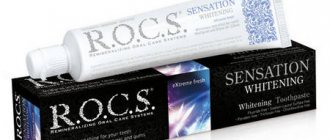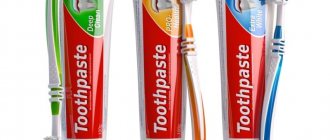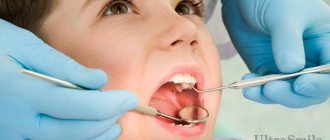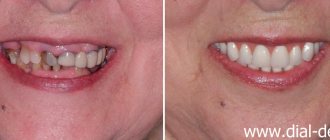Damage to tooth enamel and associated increased sensitivity of teeth is a fairly common occurrence. Some chronic diseases, bad heredity, and bad habits lead to it. The disease brings great inconvenience - because the teeth begin to react with painful impulses to cold or hot food. In advanced cases, drinking a glass of water or starting a conversation in the frosty air becomes a problem. In addition, thinning of the enamel also leads to aesthetic problems. Whitish matte spots appear on the teeth. And tooth enamel gradually loses its shine.
At the initial stage, special medicinal pastes will help cope with the problem. Today they are widely represented on the shelves of pharmacies and stores. But how to choose not just the best toothpaste for restoring tooth enamel, according to colleagues, girlfriends or marketers, but the one that can cope specifically with your problem. Let's try to understand the reasons for the thinning of tooth enamel and their consequences, and the rating of toothpastes with the effect of restoring enamel, compiled by the editors of the YaNashla website, will help with this.
Causes of thinning tooth enamel
There are many reasons for damage to tooth enamel, but all of them, as a rule, can be divided into three groups.
Bad habits
The world is full of temptations. And when lighting another cigarette or trying to chew on a pen during difficult negotiations, few people think about the harm to their teeth. Among the most common causes of enamel damage it is worth noting.
- Biting nails, pens or pencils, chewing the corner of the collar and other actions. Often they are not controlled by humans. However, such behavior should be dealt with firmly. At a minimum, it is ugly, at a maximum - you will subsequently have to shell out a large sum at the dentist.
- Smoking. Hot fumes cannot but affect the condition of the enamel, so it is worth thinking about means to get rid of the addiction.
- Love of alcoholic drinks, sweets, soda, sour juices or fruits. Acids themselves destroy the hard coating of teeth, and sugar is a breeding ground for bacteria.
- Poor nutrition. A poor diet and quick snacks often lead to a lack of microelements in the body.
Getting rid of bad habits is not easy, but it is quite possible. Especially when it comes to health. And products for sensitive teeth and enamel restoration will help improve the condition of the enamel.
Improper oral care
The desire to have a snow-white smile and fresh breath is commendable, but sometimes it leads to disastrous results. How can improper care cause damage to teeth?
- Hard brushes will clean your teeth white, but will easily damage the enamel. And together with the efforts made when brushing your teeth, they can lead to the appearance of microcracks and erosions.
- The same effect can be obtained if you often use teeth whitening products, especially those prepared at home.
It should be remembered that cracks and erosions are the most difficult to treat and can serve as a base for carious bacteria.
Complex health problems
The most difficult case is when treatment will take quite a long time. Most often they are associated with the general state of human health. Among them.
- Caries and hypoplasia of tooth enamel.
- Bad heredity. It has long been a proven fact that problem teeth are inherited from parents to children.
- Systemic and chronic diseases that cause metabolic disorders.
- Hormonal imbalances associated with diseases of the thyroid gland, adrenal glands or age-related changes.
- Malocclusion and a large number of missing teeth.
Here, medicated toothpaste will only be an additional means to reduce pain. You can achieve lasting results only by solving health problems.
Why is enamel destroyed?
Enamel is the protective shell of the tooth; it covers the entire surface of the bone tissue and prevents pathogenic bacteria from penetrating into the deep layers of dentin.
The enamel consists of:
- water;
- calcium;
- hydroxyapatite;
- magnesium;
- phosphorus;
- amino acids.
A deficiency of one of the elements can lead to a weakening of the top layer. Apart from this, there are many other reasons that lead to damage.
The main factors of enamel destruction:
- mechanical damage - eating solid food, cracking nuts, biting off thread, opening bottles;
- abrasives in bleaches;
- consumption of excessively hot and cold drinks and food;
- taking antibiotics;
- pregnancy;
- lack of micronutrients;
- smoking tobacco;
- alcohol abuse;
- dishes high in sugar and acids;
- irregular hygiene.
Attention!
To preserve the integrity of the enamel, you need to limit your consumption of foods high in sugar and acids.
What to choose from
Before choosing a toothpaste based on reviews, advice, and popularity of models, it’s a good idea to visit a dentist and get recommendations. Today, three main types of toothpastes are produced to restore enamel.
- Calcium-containing toothpastes, in which the main active ingredient is calcium compounds. The option is more gentle, but not effective in all cases. Most likely, it will not cope with microcracks and erosion.
- Fluoride-containing toothpastes are more powerful. However, their use is not recommended for long-term use. Fluoride compounds can cause the opposite effect in the form of tooth fragility.
- Combined toothpastes containing the two above-mentioned microelements.
In any case, assessing the condition of tooth enamel will not hurt, and most likely will help to avoid mistakes when choosing toothpaste to restore tooth enamel. After all, the choice is not just an oral care product, but, in fact, a medicine. And here the selection criteria are slightly different than mint or fruit flavors. Although this is also important.
Main components of hygienic pastes
The main components of hygienic pastes are abrasive particles, foaming agents, flavoring additives and sweeteners.
Any toothpaste contains a certain amount of abrasive particles , which increase the friction of the brush on the teeth and improve the mechanical cleaning of the enamel. Depending on the size and number of these particles, pastes come in different abrasiveness . Those pastes that are called whitening, in fact However, you should not get carried away with such pastes, because the abrasive they contain can erase not only plaque, but also part of the tooth enamel, damaging it and causing increased tooth sensitivity. You can use all whitening pastes only for a course of 2–4 weeks, then take a break for at least a month, after which, if necessary, the course can be repeated. For children and patients with sensitive enamel, as well as those with areas of destruction on the teeth (wear, wedge-shaped defects, enamel erosion, etc.), whitening pastes are completely contraindicated.
In addition, most toothpastes contain foaming agents that promote the appearance of foam when brushing your teeth. Most often this is inexpensive sodium lauryl sulfate (SLS). A side effect of sodium lauryl sulfate is an unpleasant feeling of dry mouth after brushing your teeth. In addition, it can cause irritation of the oral mucosa and an allergic reaction. Therefore, it is better that the paste does not contain sodium lauryl sulfate (the tube is marked “does not contain SLS” or “SLS free”). Other foaming agents have fewer side effects, but are more expensive, so their inclusion in the composition increases the cost of the toothpaste.
Flavoring additives can
The sweeteners contained in toothpaste can also be different. Most often it is sorbitol, which The best sweetener for toothpastes is xylitol; in addition to its sweet taste, it also has an antimicrobial effect.
In addition to these basic components, toothpaste may also contain medicinal components.
Calcium-containing toothpastes
The main active ingredient in these pastes is calcium and its compounds. Manufacturers also add additional components to toothpastes, including extracts of herbs and plants that have anti-inflammatory or antibacterial effects.
SPLAT Biocalcium
A well-proven toothpaste on the market for restoring tooth enamel, produced in Russia, “SPLAT Biocalcium”. It contains three active ingredients: hydroxyapatite restores and strengthens tooth enamel; calcis fills microcracks and gives them whiteness, papain prevents the proliferation of microbes and bacteria in the oral cavity.
SPLAT Biocalcium
Advantages:
- A noticeable result after a week of use, tooth sensitivity is noticeably reduced;
- Has a whitening effect;
- Normalizes pH in the oral cavity;
- Reduces the risk of tartar formation.
Flaws:
- The use of SPLAT Biocalcium toothpaste is effective at the initial stage of the disease.
There are packages on sale in volumes of 40 and 100 ml, costing 75 and 140 rubles. respectively.
President Unique
Toothpaste for restoring tooth enamel “President Unique” from an Italian manufacturer. In addition to hydroxyapatite and papain, it contains aloe extract and vitamin E, as well as spherulites from Senegalese acacia juice, which gently cleanses and whitens tooth enamel.
President Unique
Advantages:
- Quickly restores damaged enamel;
- Has anti-inflammatory and antibacterial effects;
- Prevents the formation of plaque and tartar;
- Has a beneficial effect on the gums, relieves inflammation and improves blood circulation in the tissues;
- Can be used for prevention and treatment in the initial stages of periodontal disease.
Flaws:
- Far from affordable price. A 50 ml tube costs 220-240 rubles.
According to customers, President Unique toothpaste, despite the cost, is one of the effective ways to quickly reduce tooth sensitivity.
ROCS Active Calcium
Russian-made toothpaste for restoring tooth enamel “ROCS Active Calcium” is made on the basis of hydroxyapatite, which has a regenerating effect on tooth enamel. The microelements and xylitol included in the composition normalize the microflora of the oral cavity and strengthen the gums.
ROCS Active Calcium
Advantages:
- It has a very mild abrasive effect and is suitable for people with hypersensitive teeth;
- Quickly eliminates the problem of tooth sensitivity;
- Reduces the risk of tartar formation;
- It contains no synthetic dyes.
Flaws:
- To achieve a lasting effect, toothpaste should be used for a long time;
- Not suitable for the treatment of microcracks and erosions of tooth enamel.
Available in tubes of 94 ml, costing 270 rubles.
ROCS Sensitive Restoration and Whitening
An excellent alternative to ROCS Active Calcium for people with more advanced forms of the disease. The main active ingredient is also hydroxyapatite, but in the form of a suspension. Its particles reliably seal defects and reduce tooth sensitivity.
ROCS Sensitive Restoration and Whitening
Advantages:
- Not only strengthens tooth enamel, but also eliminates its damage;
- For a short time, it reduces pain until it disappears completely;
- Suitable for mild whitening;
- The magnesium contained in the composition strengthens the gums.
Flaws:
- Despite the mildness of the effect, ROCS Sensitive Restoration and Whitening toothpaste is not recommended for use for a long time.
- Perhaps its cost. For 74 ml you will have to pay 270 rubles.
According to manufacturers, alternate use of toothpastes to restore enamel “ROCS Active Calcium” and “ROCS Sensitive Restoration and Whitening” will effectively combat the thinning of enamel without resorting to the help of heavy artillery.
Pomorin Maximum Protection
More than a third of Pomorin Maximum Protection toothpaste from a well-known Bulgarian manufacturer consists of a solution of Pomorie lye, which is responsible for restoring enamel. In addition, it contains calcium carbonate, magnesium, zinc and many other important minerals.
Pomorin toothpaste
Advantages:
- Regenerates, restores and strengthens tooth enamel;
- Kills carious bacteria and reduces the risk of caries;
- Reduces tooth sensitivity;
- Has a prolonged effect;
- Reasonable cost. A 100 ml package costs from 120 to 140 rubles.
Flaws:
- Slightly unpleasant, salty taste.
The choice of toothpastes for restoring enamel is wide. And at first it is better to do without fluoride. But if the discomfort and pain do not stop, you should not delay. It's better to see a dentist.
Why carry out enamel restoration?
The human mouth contains a huge number of different bacteria, both beneficial and harmful. If their number is balanced, inflammatory processes do not develop. But under the influence of external factors, for example, with a decrease in immunity, the accumulation of a large amount of plaque and stone, exacerbation of chronic diseases, the number of pathogenic bacteria increases sharply. And first of all, they attack tooth enamel. Gradually it is destroyed, as a result of which inflammatory processes penetrate inside - affecting the dentin, and then the nerve. That is why tooth enamel requires protection, strengthening and saturation with minerals.
Scientists were able to calculate and determine in numbers the weight of microorganisms that inhabit our body - they are about 2 kilograms, and this is almost 10 thousand types of microorganisms. At the same time, about 700 types are represented in the oral cavity. In quantitative terms, this is 40 thousand different bacteria1.
In addition, it is very important to have regular professional cleanings - not only to remove plaque and tartar from the surface of the teeth, from between teeth and from under the gums, but also to polish the enamel. This will rid the shell of the teeth of micropores, which also often become clogged with tiny bacteria, attacking the tooth literally from the inside.
Fluoride toothpastes
Fluoride is a double-edged sword. On the one hand, its compounds allow you to quickly and effectively cope with pain and damage to tooth enamel. On the other hand, it tends to accumulate in the body and increase the fragility of bones and teeth. Small children and residents of regions where there is an excess of fluoride in drinking water should not use pastes with fluoride.
The most effective active ingredients, according to the dentist, are amino fluoride and sodium fluoride.
PresidentClassic
PresidentClassic toothpaste is made in Italy. It contains sodium fluoride, which forms a protective film on the surface of the teeth. Xylitol and herbal extracts have an antiseptic effect.
PresidentClassic
Advantages:
- Quickly eliminates discomfort.
- Protects tooth enamel;
- Prevents bleeding gums.
Flaws:
- If you believe the reviews, there are none.
PresidentClassic toothpaste is sold in 50 ml and 75 ml tubes. The cost of a small package ranges from 140-160, a large one - 200-240 rubles, respectively.
Herbal Complete
“Herbal Complete” toothpaste for restoring enamel from the German company Silca. Also made with sodium fluoride, plant-derived additives and vitamin E.
Herbal Complete
Advantages:
- Provides comprehensive oral care;
- Strengthens and protects tooth enamel;
- Reduces tooth sensitivity;
- Has a pleasant fruity taste;
- Suitable for children.
Flaws:
- Long-term use is undesirable.
Miradent Mirafluor C
Miradent Mirafluor C toothpaste is made in Germany and is one of the latest developments based on amino fluoride, which allows you to build up tooth enamel.
Miradent Mirafluor C
Advantages:
- Quickly and effectively restores tooth enamel;
- Prevents the development of caries;
- Has a mild cleansing effect.
Flaws:
- Care must be taken in use to prevent an excess of fluoride in the body;
- High cost from 390 rub. for 100 ml.
Arktikum Splat
Arktikum Splat toothpaste is a Russian development based on amino fluoride. In addition, it contains papain and ratania root extract.
Arktikum Splat
Advantages:
- Builds up tooth enamel;
- Quickly copes with pain symptoms;
- Reduces the risk of developing caries;
- Has a beneficial effect on gum health;
- Has a bright refreshing aroma.
Flaws
- Impossibility of constant use.
The price for a 100 ml tube is 120-150 rubles, which is a good alternative to German toothpaste.
How is enamel strengthened?
Apadent paste with the Pro prefix is intended specifically for professional use, that is, in the dentist’s office. As a rule, it is combined with comprehensive hygiene. Both procedures take about 30-60 minutes and are carried out as follows:
- applying superficial anesthesia if necessary,
- removal of plaque and stone using ultrasound, Air Flow,
- polishing tooth enamel using a brush and regular paste without adding abrasive particles,
- applying Apadent Pro composition to the enamel, brushing each tooth for 15-20 seconds for better penetration of the active substance,
- Keep the paste on the teeth for 2-3 minutes, after which it is washed off.
As a rule, with minor demineralization, one application will be sufficient. For more pronounced pathologies, it is better to carry out the enamel strengthening procedure in a course that consists of at least 3 repetitions. This can be done both in dentistry and at home - for this the patient will need to have individual mouth guards made.
The strengthening of Apadent Pro in general has practically no restrictions - it is suitable for both children and adults. If you monitor the condition of your teeth, treat all diseases in a timely manner and do not forget about comprehensive hygiene, this paste will be an excellent assistant in maintaining the health of your entire oral cavity. But, naturally, this procedure should be carried out on a regular basis - 1-2 times a year will be enough for prevention.
Choose a toothpaste and not make a mistake
So, what criteria should you use to choose a toothpaste to restore enamel and not make a mistake? Let's start with the safest pastes, which, if they don't help, at least won't harm.
The safest toothpastes according to dentists
- Pomorin Maximum Protection;
- SPLAT Biocalcium;
- President Unique;
- Herbal Complete.
The most effective toothpastes according to customers
Efficiency and speed are good. The main thing is not to harm yourself. When choosing a toothpaste for restoring tooth enamel with powerful active ingredients, it is better to consult a doctor.
- Miradent Mirafluor C. Powerful anti-caries agent.
- PresidentClassic. An effective fluoride toothpaste.
- Arktikum Splat. Russian analogue of Miradent Mirafluor C toothpaste.
- ROCS its effectiveness lies in the use of two toothpastes of the brand “Active Calcium” and “Restoration and Whitening”.
Indications for use
This paste is prescribed to patients with increased sensitivity of the enamel, in the presence of superficial caries and foci of demineralization. It is also used as a preventive measure for many dental diseases along with comprehensive oral hygiene. The composition is completely safe for both adults and small children, even if a child swallows it, nothing will happen, because the paste contains no dyes or toxic substances.
Strengthening the enamel is also indicated before and after teeth whitening - the procedure will restore the mineral composition of the enamel and reduce sensitivity after aggressive exposure. In addition, the procedure using the paste will prolong the effect for at least six months.
The paste will also be an excellent solution for patients who wear aligners to correct their bite or are preparing to install/remove braces.
SPLAT Biocalcium
This product is a complex product. The bioactive substance is obtained from egg shells. Hydroxyapatite, which is part of the product, is a building element for hard tissues. The enamel is strengthened due to the high content of active components. They quickly reduce the increased vulnerability of crowns. A natural enzyme such as papain minimizes the risk of accumulation of dirty plaque and bacterial stone.
Normalization of pH balance is achieved through sodium bicarbonate. The product takes care of gum tissue. It safely brightens and polishes crowns. Problems are solved by saturating the damaged areas of the units with natural calcium, especially in the initial stages. Natural enzymes promote fresh breath. A noticeable result will appear after a week of using the product.
Holes in teeth: what is it and why does it appear?
Holes in the teeth, which often cause toothache, are the result of a disease called caries. The reasons for its appearance are usually:
- violation of hygiene;
- improper or insufficient cleaning of the oral cavity;
- inattention when selecting toothpaste or brush for brushing teeth;
- smoking;
- weakened immune system;
- characteristics of teeth that have a basis of heredity;
- violation of the rules of nutrition, in which salty, sweet, hot or cold food is consumed, or even a sharp transition between dishes with the opposite taste effect or temperature regime (for example, coffee-ice cream, sweet candy-hot pepper);
- mechanical damage to teeth.
If the same mistakes are repeated regularly, caries can naturally develop.
A tooth is a part of a living organism in which processes necessary for development also take place. Even when teeth have already grown, the process of demineralization and remineralization continues in an adult. It is thanks to them that all changes in the condition of the teeth occur.
As you know, human saliva contains all the components that, upon contact with the tooth surface, can be transformed into hydroxyapatite, which is the main building material for tooth enamel. There is a lot of it in the body (more than just water and collagen fibers).
Once in the mouth, food is processed by saliva and crushed by teeth. This releases fructose or sugar. The latter depends on what a person is eating at the moment. Bacteria living in plaque are activated when sugar hits the teeth, turning it into acid. The acid-base balance is disturbed. As a result, until the increased acidity in the oral cavity returns to normal, calcium and phosphorus are washed out of the teeth. Thus, demineralization occurs here.
When the acidity decreases and the alkali level returns to normal, the leaching of phosphorus and calcium stops. This process is called remineralization. During this period, it is possible to restore lost teeth to teeth by strengthening them.
There are two ways to restore the strength of tooth enamel: increased nutrition with the consumption of foods rich in calcium and phosphorus, as well as external treatment of teeth with preparations that include these substances.
Who is calcium paste recommended for?
In advanced cases, remineralizing therapy is prescribed in a clinical setting. The procedure has a good healing effect. The crowns are strengthened and the enamel layer is restored. After the session, dentists recommend using hygiene products with calcium. In addition, they are prescribed:
- With active release of mineral components and superficial caries;
- To avoid destruction of enamel;
- To stop the penetration of pathogenic microbes into dentin tissue and prevent bacterial plaque;
- If the enamel is weakly resistant to acid attack;
- When the patient has increased vulnerability of the crowns;
- If the patient has fragile units that are prone to chipping;
A simple way to strengthen crowns is to clean the chewing organs daily with pastes that have a mineralizing effect. Calcium plays a major role in the formation of bones, it maintains the integrity of incisors, fangs, molars, and prevents hyperesthesia, which appears due to thinning of the enamel.
How to choose baby toothpaste
As soon as the baby’s first tooth appears, parents should clean the mouth with special soft brushes. Children's toothpastes with calcium begin to be used at 2-2.5 years, when the child has mastered the science of mouth rinsing. It is better to use substances with a gel-like consistency. They do not contain abrasive granules and do not harm immature enamel. If problems arise with temporary units, pediatric dentists also advise using products that contain calcium.
Parents should remember that toothpastes containing fluoride are not suitable for children. This element causes side effects, especially in young children. Products for teenagers can be used after 7-8 years. Children are prohibited from using adult hygiene pastes, especially those that have a lightening effect. Such a substance as sodium bicarbonate should not be present in children's preparations. It promotes the rapid destruction of immature enamel.
How to choose pasta for an adult
During development, the chewing organs take minerals from foods. An adult's incisors, canines, and molars practically do not receive calcium from food. In order for the formed units to become stronger, they need to be saturated with calcium through the enamel. Therefore, hygiene products for adults should contain this mineral. It is important to remove dental plaque in a timely manner in a clinical setting. Studies have shown that if calcium gel or paste is applied to surface defects, they are reduced. Preparations with calcium glycerophosphate have a good effect. Before purchasing a powerful enamel restoration product, it is useful to consult a dentist.
It is difficult for the body to accept fluoride, carbonate, and gluconate. Therefore, dentists recommend preparations that contain those calcium compounds that are easily absorbed:
- glycerophosphate;
- citrate;
- pantothenate;
- lactate;
- synthetic hydroxyapatite;
Doctors do not recommend using products that contain fluorine and calcium at the same time, since their combination leads to the formation of an insoluble salt. Care with such a remedy is harmful. Active useful particles of elements will not enter solid tissues. The content of auxiliary components is important. Xylitol is beneficial. Aluminum oxide and sodium lauryl sulfate can be harmful. They disrupt metabolic processes in the body.
Causes of damage
And yet, even such hard and durable tissue can be damaged. Thus, brightly colored drinks or foods, for example, juices, tea, coffee, red wine, can leave stains on it [2]. Significant mechanical stress, such as impact or chewing very hard food, can cause cracks or chips.
However, a significant proportion of cases of enamel damage are caused by caries , that is, destruction and loss of hard tooth tissue. According to experts, another pathology, enamel erosion, is an equally serious dental problem. It is a more significant risk factor for dentin destruction than, for example, abrasion of tooth surfaces [3].
The causes of destruction of tooth enamel through erosion are [2]:
- consumption of certain fruit juices due to their high acid content;
- consumption of carbonated soft drinks due to the content of phosphoric and citric acids in them;
- weak salivation;
- high content of starchy and sweet foods in the diet;
- some diseases of the gastrointestinal tract, such as acid reflux;
- hereditary factors, for example, thin tooth enamel;
- taking certain medications;
- stress, emotional disturbances.
Types of remineralization
Artificial
The most effective way to restore teeth. It involves dental intervention. This includes:
- Coating the surface with protective varnish.
- Treatment with restorative gels.
- Use of remineralizing toothpastes.
- Thanks to this approach, damaged enamel can be restored faster.
Natural
Suitable for maintaining the mineral balance of the oral cavity, if there are no painful manifestations. Recovery occurs during nutrition, due to the microelements contained in foods. Good results can be achieved by using:
- low-fat cottage cheese;
- hard cheeses;
- legumes;
- low-fat milk;
- green vegetables.
This diet does not provide a therapeutic effect, so if problems arise, you should consult a dentist.
Symptoms of enamel destruction
Despite the fact that enamel is very durable, it is vulnerable to many factors. This means that the risk of its destruction and thinning is quite high. Especially in urban environments, where it is not so easy to find quality products, poor environment and a lot of stress.
Deterioration in the quality of enamel leads to serious consequences - it increases the risk of developing caries and other diseases. It is important to remember that although saliva partially regenerates the mineral layer, this is not enough. Restoring the mineral composition requires the use of additional measures.
In different parts of the tooth surface, the thickness of the protective layer is not the same - the closer to the root, the thinner the enamel. The chewing surface, which bears the main load, can have a protective layer of up to 2-2.5 mm. But this does not mean that enamel at the roots is not important. Although this part of the tooth is not subject to much stress when chewing, it is very vulnerable. The spread of microorganisms begins from here. Pieces of food remain under the gums and between the teeth, which creates a good environment for bacteria to multiply and, of course, it is much easier for them to destroy a thin layer of enamel. When this happens, microorganisms no longer have any special obstacles to penetrate deep into the tooth. Therefore, when the enamel is damaged, carious cavities form so easily.
To prevent this from happening, it is important to determine at an early stage that the protective layer is damaged. This can be done based on the following symptoms:
- tooth sensitivity has increased - when exposed to cold, hot food, sour foods, a sharp pinching pain appears;
- pain appears with any small impact, for example, inhaling cold air;
- the teeth have become dull and have lost their shine;
- yellow spots are visible on the surface of the protective layer;
- the enamel in some areas became dull and rough, and the first signs of caries appeared.









